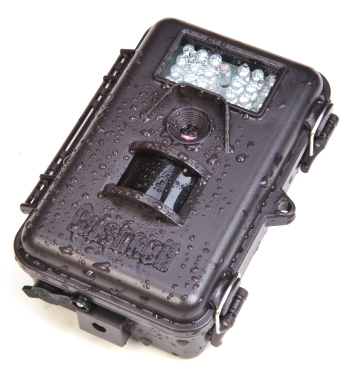 I know, pretty spiffy motto for the post office, but actually a paraphrase of Herodotus describing the Persian method of swift message delivery circa 480 BC. Herodotus wrote, “It is said that as many days as there are in the whole journey, so many are the men and horses that stand along the road, each horse and man at the interval of a day’s journey; and these are stayed neither by snow nor rain nor heat nor darkness from accomplishing their appointed course with all speed”.
I know, pretty spiffy motto for the post office, but actually a paraphrase of Herodotus describing the Persian method of swift message delivery circa 480 BC. Herodotus wrote, “It is said that as many days as there are in the whole journey, so many are the men and horses that stand along the road, each horse and man at the interval of a day’s journey; and these are stayed neither by snow nor rain nor heat nor darkness from accomplishing their appointed course with all speed”.
All in all, the Herodotus comments seemed a bit of a backhanded compliment to the Persians as it praised King Xerxes for getting a message so rapidly back home to Persia, but the message was to advise that the Greeks had destroyed the Persian fleet off the coast of Salamis.
In the case of the Bushnell Trophy Cam the persistence in delivery reference is purely intended to be a compliment; no backhandedness is applied. During a period of approximately three weeks, the little camera saw Maine’s typical seasonal whacky weather including temperature swings from 30°F – 75°F, dry weather followed by torrential rainfall and overnight windstorms that had big pines developing a permanent leeward list. The unit was strapped to a tree, mounted to a tripod and left on the porch steps…and it didn’t even end up in a fraternity.
Tale of the tape…
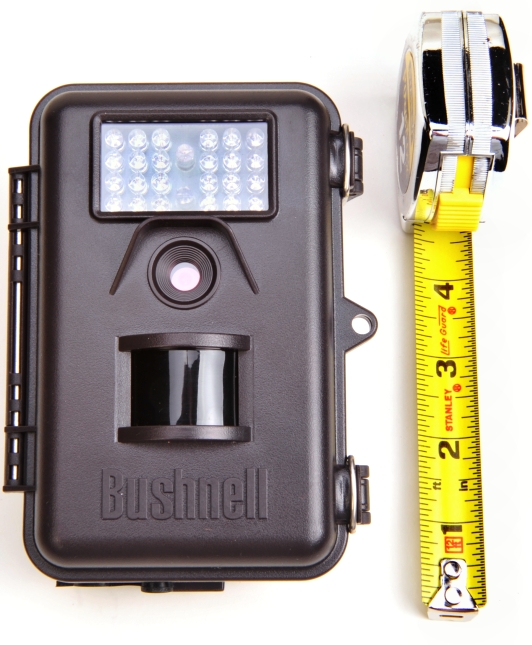
|
||||||||||||||||||||||||||||||||||||||||
Information that doesn’t fit in boxes…
The unit is compact, light and well built. The gasket sealed rugged poly case is water tight. There aren’t a lot of open places even with the case open.
Set up is easy, the menu system is intuitive and there are enough parameters to adapt the unit to almost any environment; hours active, sensitivity of infrared motion sensor, length of video, number of photos to take at what intervals, etc.
Playback is easy, whether looking at the color LCD display on the inside back of the unit, or using the included USB cable to playback on a big screen TV or computer screen. File upload is as simple as off loading a digital camera.
The unit runs on AA batteries…and runs, and runs, and runs, etc.
Some stuff inside…
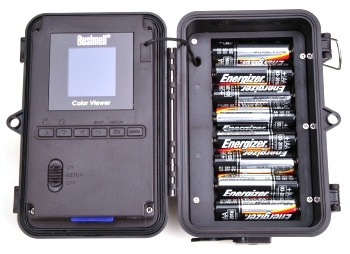
Making the Trophy Cam operational requires only unsnapping the case, inserting 4 or 8 AA batteries (a year’s worth of battery life with 8 installed), adding an SD memory card of 2 GB or less capacity and accomplishing some basic set up. In fact, the unit will run as received, but setting the unit’s time and date, making a still or video image determination, selecting resolution level, etc. will make it fit your individual preferences. Navigation is easy with scroll and execute (OK) keys. The three way switch positions are: off, set up and on. Color text is displayed in setup mode, color images and/or video in Viewscreen mode.
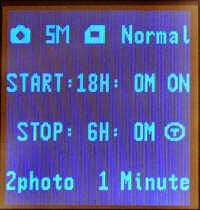 The 1.7″ display is bright, visible even in sunlight. Pictured is the status screen that shows at a glance how the camera is set up; camera stills, 5 MB hires images, Normal sensor sensitivity, timed to run between 6PM and 6 AM, images are time stamped, 2 photos per trigger, 1 minute delay between triggers, etc. The same capability is available in the LCD text screen version of the product.
The 1.7″ display is bright, visible even in sunlight. Pictured is the status screen that shows at a glance how the camera is set up; camera stills, 5 MB hires images, Normal sensor sensitivity, timed to run between 6PM and 6 AM, images are time stamped, 2 photos per trigger, 1 minute delay between triggers, etc. The same capability is available in the LCD text screen version of the product.
This model’s color Viewscreen feature allowed me to check the camera’s captured images right at the camera. There was not need to collect the unit and bring it to a PC or TV, nor did I have to bring a notebook computer out to the camera. This made it a lot easier to make field placement adjustments.
Is that a kitty cat?
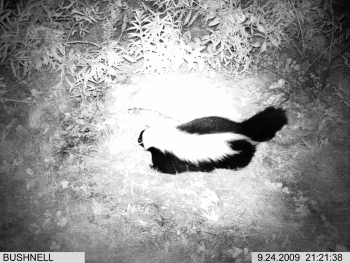
One of the great things about living in the boonies is the menagerie that lives all around us. In fact, we are always betting on what is occupying what den along the stone fence or making noise at night from under the porch. So we began parking the Trophy Cam over den holes, pictured left. This shot was taken on a moonless night in an area where there is no ambient light.
We collected lots of pictures, which we emailed to the grandkids which, of course, caused them to get excited and call us…our plan in the first place. Reviewing the results of a trail camera makes for fun family time.
And just inside the tree line…
Video of deer taken in very early morning light (ignore the time displayed, I hadn’t yet set the cameras time/date) came out very good. Nothing was disturbed by the presence of the camera. I was surprised by the number of deer residing just outside of the lawn line at the entrance to a small clearing. The second video was a bit of a concern. If you watch the deer’s movements you’ve got to wonder what the cause was of the reaction.
Not since the Magic Eight Ball…
The Trophy Cam incorporates a PIR, Passive InfraRed, sensor. Yes, I did notice how the semiconductor industry changes the spelling of “infrared” to make it three letter acronym ready. The sensor reads infrared output from objects in its field of view and interprets change in these levels and locations as motion. Infrared level increase with temperature, so a warm blooded animal moving across the sensor’s field of view is recognized as an animal that is in motion. The sensor is the radiused piece just above “Bushnell in the picture”. It has a maximum range of 45 feet and is selectable for three levels of sensitivity. Typically, colder weather means less sensitive settings as the contrast between a warm blooded animal and backdrop is much greater so it is easier for the sensor to detect the difference. The motion detection sensor range works out as it is almost identical to the LED Infrared flash.
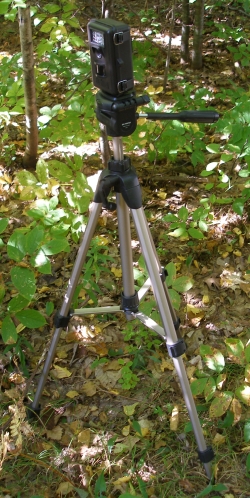 Optimal distance from camera to area being monitored is 17 feet, which makes sense with the depth of field provided by an f 3.1 fixed focus lens. Again, this is optimal distance, by no means distance limitations. I shot stills at less than 3 feet and good video out beyond 30 feet without difficulty.
Optimal distance from camera to area being monitored is 17 feet, which makes sense with the depth of field provided by an f 3.1 fixed focus lens. Again, this is optimal distance, by no means distance limitations. I shot stills at less than 3 feet and good video out beyond 30 feet without difficulty.
The lens field of view is 40° which approximates a normal focal length lens of 38mm for 5 Megapixel digital cameras and 50mm for 35mm format film cameras. The unit’s environmental operating range is -4°F – 140°F and 5% – 90% humidity. As previously noted, we had the camera out in sunshine and rain, cold and warm weather; none of which seemed to have an effect on the camera’s operation.
Picture sizes are 5MP=2560×1920, 3MP=2048×1536. Video images of 640×480 are shot at 16fps, 320×240 at 20 fps. A 2 GB cards holds approximately 4,000 3MP images, 2,400 @ 5MP. The same card can hold 60 minutes of 640×480 video and 120 minutes of 320×240. An SD card is not packaged with the unit, however, the price these days for a memory card is in the $12 range. Because the Trophy Cam is a card based product, it is also reasonable to bring spare cards out for a camera check and swap them out in the field, full for fresh.
The Trophy Cam draws only 150mA when monitoring and an additional 450mA when Infrared lighting is triggered and operational. Current draw in standby mode is only 0.35mA. To put this in context, from a guy who is always complaining about notebook/netbook battery life, the whole Trophy cam draws 1/8th the power of a single tiny 2″ netbook hard drive when monitoring and approximately half the draw of the same drive when the camera is actively shooting and lighting an area with Infrared at night. So the 8 AA batteries for a years worth of unit power seems plausible and this low power consumption was reflected during my use of the product. There is a power interface at the base of the unit that permits the use of an external 6v DC power source.
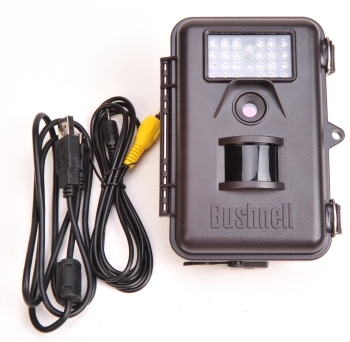 NTSC TV out and USB cables are included in the package, an SD card holder in integral to the camera. No Bushnell product application software is required to connect to any of the noted interfaces. I plugged the unit into several notebook and office Windows based systems without a hiccup. In all cases the Trophy Cam triggered the standard software used to upload digital camera images; adobe, Nikon and Corel down loaders. Each interfaced properly with the camera to delete images after transfer, consistent with my software’s preference settings. Via USB, the Trophy Cam was plugged into the Toshiba big screen that normally is reserved for showing only NY Giant football games. The TV and camera recognized one another and the TV remote served to launch video & JPG files for TV screen viewing.
NTSC TV out and USB cables are included in the package, an SD card holder in integral to the camera. No Bushnell product application software is required to connect to any of the noted interfaces. I plugged the unit into several notebook and office Windows based systems without a hiccup. In all cases the Trophy Cam triggered the standard software used to upload digital camera images; adobe, Nikon and Corel down loaders. Each interfaced properly with the camera to delete images after transfer, consistent with my software’s preference settings. Via USB, the Trophy Cam was plugged into the Toshiba big screen that normally is reserved for showing only NY Giant football games. The TV and camera recognized one another and the TV remote served to launch video & JPG files for TV screen viewing.
Practical purposes..
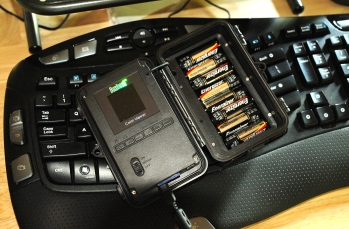
Primarily, the Trophy Cam is a quality game trail camera. Placed in an area under consideration for hunting, types of game and time of day appearances can be analyzed for opportunity.
For children and adults, the Trophy Came provides unique insight into the types of animals that frequent an area and something about their diet and activity. Where there were tracks or droppings we couldn’t associate with a particular animal, we put the camera out in the area and investigated.
All and all it led to a fun adventure for grandparents, parents and children. It also helped us past that sticky point where family comes to visit a rural area and expects to see wildlife on the front lawn having a picnic. One of the reasons I don’t like Disney animated films, they build unreasonable expectations. You try explaining to a two year old why a rabbit won’t stop to chat with them. In a more real world the kids can go out for camera checks and get excited about what they may find…even if that’s grandpa tripping on the trail and ending up in the bushes…the incident captured on camera.
The Trophy Cam is also an excellent security device. With relatively low cost, long battery life, night vision and selective image capture the camera is a natural for surveillance of any areas of concern. The Trophy Cam is silent, the case can be locked and the camera can be secured high in a tree and away from typical line of sight. Good product.

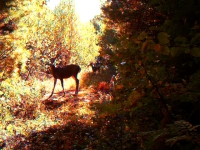
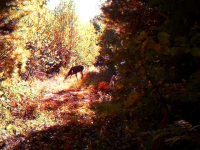
Email Notification